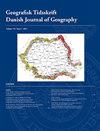IF 1.1
4区 社会学
Q4 ENVIRONMENTAL STUDIES
Geografisk Tidsskrift-Danish Journal of Geography
Pub Date : 2020-01-02
DOI:10.1080/00167223.2020.1771005
引用次数: 0
摘要
亨里克·布吕宁-马德森出生在腓特烈斯堡。1975年获自然地理学硕士学位,1978年获博士学位。1983年,Breuning-Madsen博士凭借论文《海默尔土地的土壤条件》获得博士学位,随后在农业部工作。随后,他开始了漫长而成功的大学生涯,先是担任副教授,1991年成为哥本哈根大学地理系土壤地理学正教授。Breuning-Madsen的研究是基于与作物根系发育和作物灌溉需求相关的土壤保水。在20世纪80年代,breuning - madsen对赭石潜在土壤进行了调查,并开发了一种新的方法来绘制地图。Breuning-Madsen同时也是一个项目的负责人,该项目收集了大约2000个土壤剖面,这对丹麦土壤数据库的建设起了核心作用,该数据库今天是欧洲最详细的土壤数据库之一。从20世纪90年代开始,BreuningMadsen就参与建立了一个与欧洲土壤地图相连的土壤分析数据库,即欧洲土壤数据中心(ESDAC)。1991年至2015年期间,Breuning-Madsen负责在阿克拉的加纳大学建立土壤和水分析实验室EcoLab。其目的是为硕士和博士学生提供一个为他们的论文生成经验数据的机会,自那以后,已有数百名学生使用了该实验室。加纳和丹麦的研究人员之间建立了合作项目,Breuning-Madsen在加纳发起了一些具体的研究项目。作为这些活动的一部分,Breuning-Madsen发起了同行评议期刊《西非应用生态学杂志》的出版。1993年,在丹麦的一个青铜时代的墓葬堆中发现了一系列无法解释的氧化铁层。根据对几个墓葬的化学分析,以及在Lejre历史考古研究中心建造的实验墓葬,BreuningMadsen得出结论,这是氧化还原过程,产生了青铜时代墓葬周围的铁层。2009年,他的研究集中在丹麦日德兰半岛中部著名的耶林土丘的泥炭层和保存植被的起源上。他得出结论,维京时代粘土的碳含量明显高于现代粘土的平均含量。这是1850年以后粘土流失的结果。这些项目是他对历史和考古研究的极大兴趣的典范,这成为许多创新项目的焦点,经常与丹麦国家博物馆合作。Henrik Breuning-Madsen在丹麦皇家地理学会的管理中发挥了几十年的关键作用。他于2004年加入协会管理层,成为董事会成员,并于2015年当选为副主席,他一直担任这个职位,直到去世。他以自己的研究成果为基础,在学会做了几次讲座,并担任了几年《丹麦地理杂志》的主编。他深入参与了该学会的现代化建设,并使其历史发现和资产的收藏易于使用。其中包括该协会的照片档案的数字化,这些照片包括自20世纪初以来在全球旅行和探险中拍摄的7万多张照片。Henrik Breuning-Madsen是一个正在进行的关于丹麦探险历史的大型书籍项目的幕后推手之一,该项目与国家博物馆合作,并得到奥古斯丁基金会的资助,将描绘具有里程碑意义的丹麦探险。丹麦皇家地理学会失去了一位伟大的人格和一位好朋友。Henrik BreuningMadsen教授对地理学的重大贡献和对学会的奉献,以及他的许多学术成就,将永远被人们铭记。本文章由计算机程序翻译,如有差异,请以英文原文为准。
Henrik Breuning-Madsen (1949-2018)
Henrik Breuning-Madsen was born in Frederiksberg. He received a Master degree in physical geography in 1975 and a PhD degree in 1978. In 1983, Breuning-Madsen was awarded a Doctorate degree based on the dissertation “Himmer land’s Soil Conditions” and was subsequently employed at the Ministry of Agriculture. Later, a long and successful university career followed, first as associate professor and in 1991 Breuning-Madsen became full professor of soil geography at the Department of Geography, University of Copenhagen. Breuning-Madsen’s researchwas based on soil retention of water linked to crop root development and thus crop irrigation needs. In the 1980s, Breuning-Madsenworked on a survey of ochre potential soils and developed a new method to map this. Breuning-Madsen was at the same time the leader of a project that collected around 2000 soil profiles, which played a central part for the construction of the Danish Soil Database, which today is among the most detailed soil databases in Europe. From the 1990s BreuningMadsen was involved in establishing a soil analysis database linked to the European soil map, known as European Soil Data Centre (ESDAC). During the period 1991–2015, Breuning-Madsen was responsible for establishing EcoLab, a soil and water analysis laboratory at the University of Ghana in Accra. The purpose was to give Master and Ph.D. students an opportunity to generate empirical data for their dissertations, and hundreds of students have since used the laboratory. Collaboration projects were established between Ghanaian and Danish researchers, and Breuning-Madsen initiated a number of concrete research projects based in Ghana. As part of the activities, Breuning-Madsen initiated the publication of the peer-reviewed journal West African Journal of Applied Ecology. In 1993, a series of unexplainable iron oxide layers were discovered in a Bronze Age burial mound in Denmark. Based on chemical analyses from several burial mounds and the construction of experimental mounds at the Lejre Historical Archaeological Research Centre, BreuningMadsen concluded, that it was the redox processes, which created the iron layers that surround coffins buried in Bronze Age mounds. In 2009, his research focussed on the origins of layers of peat and conserved vegetation in the famous Jelling burial mounds in central Jutland, Denmark. He concluded that the carbon content of clay soil in the VikingAgewas clearly higher than the averagemodern clay soil. This was attributed to the drainage of clay soils after 1850. These projects are exemplary of his great interest in historical and archaeological research, which became the focus of many innovative projects, frequently in collaboration with the National Museum in Denmark. Henrik Breuning-Madsen played a key role in the management of the Royal Danish Geographical Society for several decades. He joined the Society management as a board member in 2004 and was elected vice-president in 2015, a position he held with great commitment until his death. He contributed by giving several Society lectures based on his research and served as Editor in chief of the Danish Journal of Geography for several years. Hewas deeply involved in bothmodernizing the Society as well as making its collection of historical findings and assets accessible. These include the digitization of the Society’s photo archive consisting of more than 70,000 images taken on travels and expeditions across the globe since the early1900’s. Henrik Breuning-Madsen was one of the driving forces behind a large, ongoing book project on Danish expedition history, which in collaboration with the National Museum and with funds from the Augustinus Foundation will portray landmark Danish expeditions. The Royal Danish Geographical Society has lost a great personality and a good friend. Professor Henrik BreuningMadsen will always be remembered for his significant contribution to Geography and dedicated service to the Society as well as his many academic achievements.
求助全文
通过发布文献求助,成功后即可免费获取论文全文。
去求助
来源期刊
CiteScore
5.20
自引率
0.00%
发文量
5
期刊介绍:
DJG is an interdisciplinary, international journal that publishes peer reviewed research articles on all aspects of geography. Coverage includes such topics as human geography, physical geography, human-environment interactions, Earth Observation, and Geographical Information Science. DJG also welcomes articles which address geographical perspectives of e.g. environmental studies, development studies, planning, landscape ecology and sustainability science. In addition to full-length papers, DJG publishes research notes. The journal has two annual issues. Authors from all parts of the world working within geography or related fields are invited to publish their research in the journal.

 求助内容:
求助内容: 应助结果提醒方式:
应助结果提醒方式:


